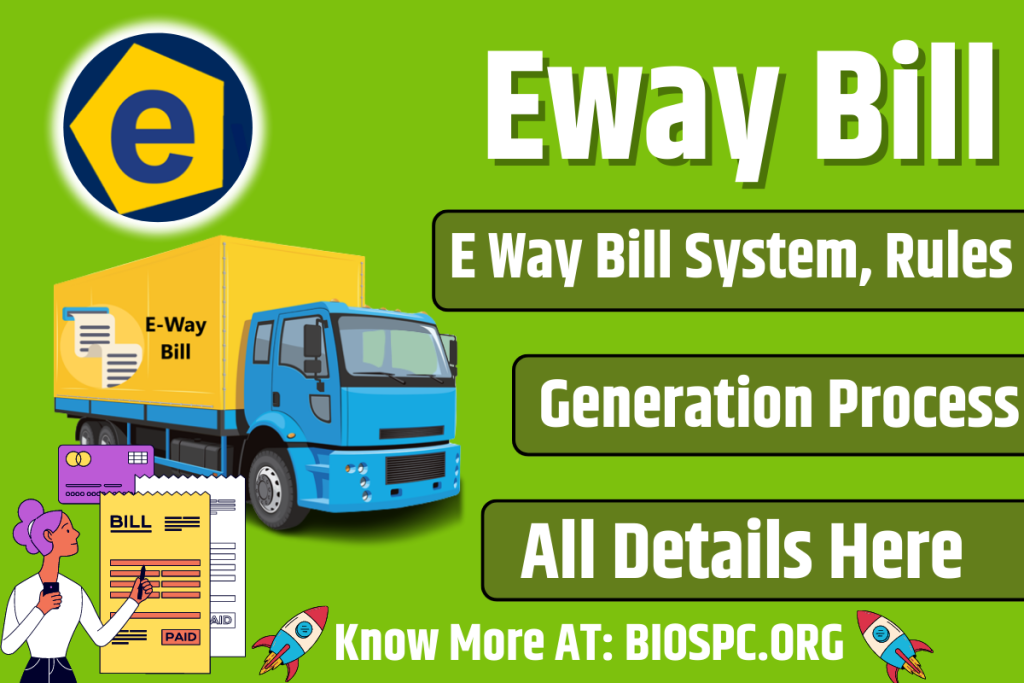An e-way bill, short for Electronic Way Bill, is a document used to monitor the movement of goods during transit, introduced under the Goods and Services Tax (GST) system. Any individual registered under GST and transporting goods valued at over Rs. 50,000 must possess an Eway bill Download generated through the GST Portal. LEDGERS has streamlined the process of generating and managing eway bill generation for businesses. The Ledgers Eway bill validation tool is synchronized with GST invoices, bills of supply, purchase invoices, and customer/supplier accounts.
Generating eWay Bills has been made extremely simple, just a click away, and these bills can be easily shared with customers or suppliers. The E-way bill rules outline the guidelines for managing the movement of goods. However, it’s important to note that the implementation of E-way bill was deferred when the GST Act came into effect on July 1st.
What is an eWay Bill?
EWay Bill is a digital document created on the eWay Bill Portal for tracking the movement of goods. A person registered under GST must produce an e-way bill on ewaybillgst.gov.in when transporting goods in a vehicle with a value exceeding Rs. 50,000 (Single Invoice/bill/delivery challan).

In addition, an Eway bill can be produced or revoked via SMS, the Android App, or site-to-site integration using API by entering the accurate GSTIN of the involved parties. It’s crucial to authenticate the GSTIN using the GST search tool before utilization.
Upon generating an Eway bill, a distinctive Eway Bill Number (EBN) is assigned, and accessible to the supplier, recipient, and transporter.
When Should eWay Bill be issued?
An eWay bill is generated when goods are transported in a vehicle or conveyance with a value exceeding Rs. 50,000, whether for each invoice or the combined total of all invoices within that vehicle or conveyance.
- About a ‘supply’
- For reasons other than a ‘supply’ ( say a return)
- Due to inward ‘supply’ from an unregistered person
For this purpose, a supply may be either of the following:
- A supply made for a consideration (payment) in the course of business
- A supply made for a consideration (payment) which may not be in the course of business
- A supply without consideration (without payment)In simpler terms, the term ‘supply’ usually means a:
- Sale – sale of goods and payment made
- Transfer – branch transfers for instance
- Barter/Exchange – where the payment is by goods instead of in money
Therefore, eWay Bills must be generated on the common portal for all these movements. For certain specified Goods, the eway bill needs to be generated mandatorily even if the value of the consignment of Goods is less than Rs. 50,000:
- Inter-State movement of Goods by the Principal to the Job-worker by Principal/ registered Job-worker
- Inter-State Transport of Handicraft goods by a dealer exempted from GST registration
Who should Generate an eWay Bill?
Registered Person:
- Eway bill generation is mandatory when moving goods valued at more than Rs 50,000 to or from a registered person.
- A registered person and the transporter can generate and carry an eWay bill even if the goods’ Eway Bill Download value is below Rs 50,000.
Unregistered Persons:
- Unregistered individuals are also required to create an e-Way Bill.
- In cases where an unregistered person supplies goods to a registered person, the recipient must ensure all compliance Eway Bill Download obligations are fulfilled as if they were the supplier.
Transporter:
- If the supplier hasn’t generated one, transporters handling goods through road, air, rail, etc., must generate an e-Way Bill.
What is the eWay bill format?
The E-way bill consists of two parts Part A and B. The Part A of the E-way bill collects the details related to consignment, usually the invoice details. Accordingly, the following information needs to be submitted.
- GSTIN of the recipient must be submitted.
- The Pin code of the place where goods are delivered needs to be mentioned.
- The invoice or the challan number against which the goods are supplied must be submitted.
- The value of consignment is to be mentioned.
- HSN code of the goods which are transported should be entered. If the turnover is up to INR 5 crores, the HSN code’s first two digits should be mentioned. A four-digit HSN code is required if the turnover exceeds INR 5 crores.
- The reason for transportation should be predefined, and the most appropriate one should be selected.
- The transport document number should be indicated. It includes goods receipt number, railway receipt number, airway bill number.
The transporters need not generate the Eway bill (as Form EWB-01 or EWB-02) where all the consignments in the conveyance :
- Individually(single Document) is less than or equal to Rs 50,000 BUT
- In Aggregate (all documents put together) exceeds Rs 50,000
Document means Tax Invoice/Delivery challan/Bill of supply
Unregistered Transporters will be issued Transporter ID on enrolling on the e-way bill portal after which Eway bills can be generated.
| Who | When | Part | Form |
|---|---|---|---|
| Every Registered person under GST | Before movement of goods | Fill Part A | Form GST EWB-01 |
| Registered person as consignor or consignee (mode of transport may be owned or hired) OR recipient of goods | Before movement of goods | Fill Part B | Form GST EWB-01 |
| Registered person as consignor or consignee, and goods are handed over to transporter | Before movement of goods | Fill Part B | The registered person shall furnish the information relating to the transporter in Part B of FORM GST EWB-01 |
| Transporter of goods | Before movement of goods | Generate e-way bill on basis of information shared by the registered person in Part A of FORM GST EWB-01 | |
| An unregistered person under GST and recipient is registered | Compliance to be done by Recipient as if he is the Supplier. | 1. If the goods are transported for a distance of fifty kilometers or less, within the same State/Union territory from the place of business of the consignor to the place of business of the transporter for further transportation, the supplier or the transporter may not furnish the details of conveyance in Part B of FORM GST EWB-01. 2. If supply is made by air, ship or railways, then the information in Part A of FORM GST EWB-01 has to be filled in by the consignor or the recipient |
Note: When a transporter moves multiple shipments within one vehicle, they can generate a consolidated e-way bill using form GST EWB-02. This is done by inputting the e-way bill numbers for each consignment. Suppose neither the sender (consignor) nor the receiver (consignee) has generated an Eway Bill Download. In that case, the transporter can create one by completing PART A of FORM GST EWB-01 using the information from the Eway Bill Download provided invoice, bill of supply, or delivery challan.
Cases when eWay bill is Not Required
In the process cases it is not necessary to generate e-Way Bil:
- Non-motor vehicles as the mode of transport
- Transportation of goods from Customs port, airport, air cargo complex, or land customs station to Inland Container Depot (ICD) or Container Freight Station (CFS) for Customs clearance.
- Movement of goods under Customs supervision or with customs seal
- Transportation of goods under Customs Bond from ICD to Customs port or between custom stations
- Transit cargo movement to or from Nepal or Bhutan
- Movement of goods directed by defense formation under the Ministry of Defence as consignor or consignee
- Transporting empty cargo containers
- Consignor moving goods to or from the place of business and a weighbridge for weighment within a 20 km distance, accompanied by a Delivery Challan.
- Goods are transported by rail where the Consignor is the Central Government, State Governments, or a local authority.
- Goods are specifically exempt from eway bill generation per State/Union territory GST Rules.
- Transport of certain specified goods, including exempt supply, goods treated as no supply, and specific schedule to Central tax rate notifications.
State-wise e-Way Bill Rules and Limits
Since its introduction on April 1st, 2018, there has been a notable increase in the generation of e-way bills for Inter-State movement of goods. Adopting the e-way bill system state-wise has yielded positive results, as all States and Union Territories have joined in generating e-way bills for intra-State movement of goods.
Generating an E-Way Bill: Essential Documents and Format
The E-Way bill ensures seamless movement and compliance in goods transportation. Specific documents are required to generate an E-Way bill, and adherence to the prescribed format is essential. This article sheds light on the prerequisites for generating an E-Way bill and delves into the format that structures this crucial document.
Requisite Documents for E-Way Bill Generation
Generating an E-Way bill necessitates certain essential documents, depending on the mode of transport. Here’s a breakdown:
- For transport by road:
- Invoice/Bill of Supply/Challan: About the consignment of goods.
- Transporter ID or Vehicle Number: Essential for road transport.
- For transport by rail, air, or ship:
- Invoice/Bill of Supply/Challan: As relevant to the consignment.
- Transporter ID, Transport Document Number, and Date: Crucial for rail, air, or ship transport.
The Format of the E-Way Bill
The E-Way bill is structured in two parts, namely Part A and Part B. Part A captures vital consignment details, often aligning with the invoice particulars. Here’s a breakdown of the key information required in Part A:
- Recipient’s GSTIN: The GST Identification Number of the recipient.
- Delivery Pin Code: The Pin code of the destination where the goods will be delivered.
- Invoice/Challan Number: The unique number associated with the invoice or challan under which the goods are supplied.
- Consignment Value: The value of the transported goods.
- HSN Code of Goods: The Harmonized System of Nomenclature (HSN) code of the goods transported. For turnovers up to INR 5 crores, the first two digits of the HSN code are to be mentioned. For turnovers exceeding INR 5 crores, a four-digit HSN code is required.
- Reason for Transportation: Select the predefined and most relevant reason for the transportation.
- Transport Document Number: This includes the goods receipt number, railway receipt number, or airway bill number, depending on the mode of transport.
Conclusion Electronic Way Bill
The process of generating an E-Way bill is streamlined through the submission of essential documents and adherence to a structured format. This ensures that goods can be transported seamlessly while complying with regulations. By furnishing accurate information and understanding the significance of each detail, businesses contribute to efficient logistics and a robust supply chain.
Table: Components of the E-Way Bill
| Section | Summary |
|---|---|
| Requisite Documents | Discussion of required documents for E-Way bill generation. |
| Transport by Road | Documents needed for road transport. |
| Transport by Rail, Air, or Ship | Documents necessary for diverse modes of transport. |
| The Format of the E-Way Bill | Detailed breakdown of Part A of the E-Way bill. |
| Conclusion | Recognizing the importance of accurate E-Way bill information. |
Nonetheless, some states have offered exemptions to their residents by not requiring e-way bill generation for transactions falling below a certain monetary threshold or involving specific items. For instance, Tamil Nadu exempts its residents from e-way bill generation if the item’s value is below Rs. One Lakh. To find out about similar exemptions in other states or union territories, you can refer to our page on state-specific e-way bill rules and threshold limits. Alternatively, you can also check the commercial tax websites of each respective state or union territory for further information.
How to generate eWay Bill on portal
You can generate the E-Way Bill and obtain the e-way bill number through the e-Way Bill Portal. All you require is a login for the Portal. For a comprehensive, step-by-step guide on generating an e-Way Bill, refer to our article “Guide to Generate E-Way Bill Online.”
SMS e-way bill generation on mobile
You can eway bill generation through SMS using a registered mobile phone. To start, activate the SMS eway bill generation feature. Register the designated mobile phone for e-way bill generation via SMS. Subsequently, send specific SMS codes to a designated mobile number managed by the Eway Bill Download /GSTN to create, manage, or cancel e-way bills. For more comprehensive information, refer to our article discussing the “SMS Mode of E-Way Bill Generation.”
Validity of E-way Bill
An e-way bill is valid for periods listed below, based on the distance travelled by the goods. Validity is calculated from the date and time of eway bill generation of e-way bill-
| Type of conveyance | Distance | Validity of EWB |
| Other than Over dimensional cargo | Less Than 200 Kms | 1 Day |
| For every additional 200 Kms or part thereof | additional 1 Day | |
| For Over dimensional cargo | Less Than 20 Kms | 1 Day |
| For every additional 20 Kms or part thereof | additional 1 Day |
The validity of the Eway bill can also be extended. The Eway bill generation of such Eway bill has to be either eight hours before expiry or within eight hours after its expiry can extend Eway bill validity eway bill generation.
Documents or Details required to generate eWay Bill
- Invoice, Bill of Supply, or Challan relevant to the goods consignment
- For road transportation – either Transporter ID or Vehicle number
- For rail, air, or ship transportation – Transporter ID, Transport document number, and document date
FAQ’S Eway Bill
You cannot generate a single Electronic Way Bill against two invoices.However, you can use consolidated e-way bill to club two or more e- way bills.
Yes, only on authorization from the registered person can the transporter furnish the details in Part A of Form GST-EWB-01 Eway Bill Download.
When the goods to be transported are supplied through an e-commerce operator or a courier agency, on an authorization Eway Bill Download received from the consignor, the information in Part A of FORM GST EWB-01 may be furnished by such e-commerce operator or courier agency and a unique number will be generated on the said portal. Electronic Way Bill
In this case, the Electronic Way Bill shall be generated by the principal or job-worker, regardless of the consignment’s value, if registered.
The consignment value of goods shall be the value, as declared in an invoice, a bill of supply or a delivery challan, as the case may be, issued in respect of the said consignment and also includes the central tax, State or Union territory Electronic Way Bill tax, integrated tax and cess charged Electronic Way Bill.
The registered person shall furnish the details in Part-A of the Form GST-EWB-01. Based on the registered person’s information, the transporter shall furnish the details in Part-B and generate the Electronic Way Bill






